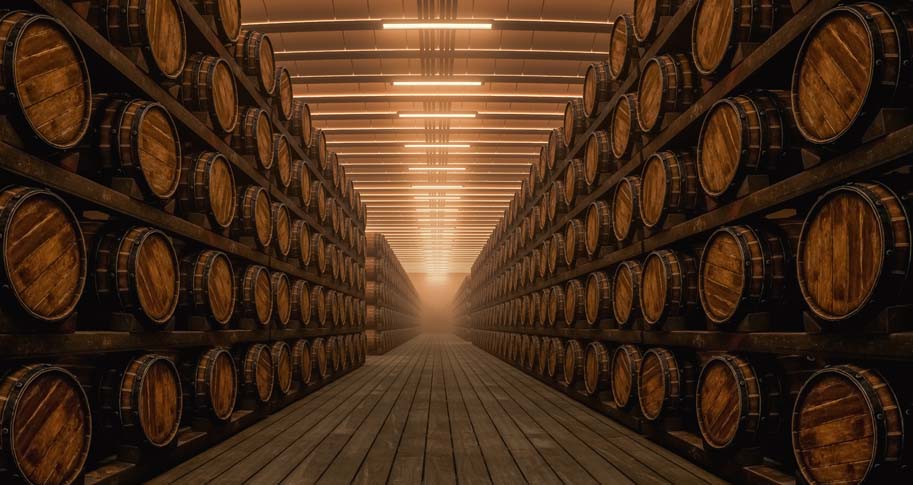
Balcones Distilling opened its doors in 2008. Despite its recent conception, it is
a historic distillery in Waco, Texas, releasing Texas’s first whiskey since Prohibition.
At the rate modern Americans are drinking, that might seem surprising, but distilleries and liquor production tend to have
much more stringent regulations compared to breweries, making distilleries particularly difficult businesses to open and operate.
Undaunted, Chip Tate, the founder of Balcones, learned the skills he would need to
operate an artisanal distillery on Islay, world renowned for its peaty, smoky, burnt-tire-but-in-a-good-way Scotches, and brought craft whiskey
to the Lone Star State.
Tate’s whiskey slaked an insatiable thirst for craft liquor in Texas. With a product known for years’ and decades’ long aging, Balcones Distilling just kept winning awards for its whiskeys in the first years of its operation. Demand quickly outpaced production. Tate needed the capital to
invest in a bigger space with more production capacity. But he wanted a particular
kind of investor, one who shared his passion for making a craft product and building
a sustainable, generational brand that they could both pass down to their children
and grandchildren.
Like a business relationship, a whiskey is the sum of its parts. The distiller blends
the barrels trying to balance the quixotic qualities of an aged product. It takes
a discerning palate to pick barrels and mix them in the right ratios to make the best
whiskey. With equal care, Tate vetted potential investors, turning away some initial
interest before he met Greg Allen, an Oklahoma City based investor. They met when
Allen was visiting Balcones to research an unrelated opportunity to invest in a Virginia
distillery.
Initially, Allen and Tate seemed like the perfect entrepreneur-investor pair. Allen
had the business outlook that Tate sought to complement his product and storytelling
expertise. When the deal was finalized, they drew up a charter that clearly and legally
delineated their roles in the business.
They seemed the textbook case of a mutually beneficial entrepreneur-investor relationship. Seeking investor capital often means entrepreneurs accepting they’ll have to make
some sacrifices. Owners often do not retain majority ownership of the enterprise when they accept investors’ money. In this view, investors decide
to invest in the business, not who’s at the helm.
So, if the owner and their investors have any sort of falling out, investors maintain
a financial upper hand because owners sell investors their majority stake as part of an investment deal.
With that financial power, it seems like a foregone conclusion that the investor will
win control in almost every case.
Oleg Petrenko, University of Arkansas professor of entrepreneurship, notes that this would not
constitute a true rivalry. The investors’ victory is a foregone conclusion when raw, fiduciary power is the only
measure we consider in these affairs. Petrenko argues that this metric does not capture the full picture of the entrepreneur-investor
relationship, that there are other aspects to consider, which make the outcome of
a falling out less predictable.
In “Entrepreneur-investor rivalry over new venture control: The battle for Balcones Distilling,” Petrenko and his coauthors, Theodore Waldron, Jeffery McMullen, Lori Tribble Trudell, and Olivia Aronson, lay out a theoretical framework to better understand the dynamics
at play when business owners and their investors no longer see eye to eye. They apply
research insights on firm level rivalry to the understudied dynamics of interpersonal relationships. Their work extrapolates
on the public row between Chip Tate and Greg Allen, and with it, they hope to engender
new, compelling research on the dynamics of entrepreneur-investor relations.
Setting a Foundation
The researchers chose Balcones Distilling’s entrepreneur-investor fallout because
the business is part of a craft industry, where passions can run a little hotter.
Moreover, it became public and is also well documented, from news stories to court documents. The researchers say that many such relationships end quietly,
and we can’t study what we don’t know. The distillery proved a perfect qualitative
test case to lay the foundation for future quantitative research.
After an initial honeymoon, Tate and Allen’s working relationship began to deteriorate.
Tate initially asked Allen for a $4.5 million investment to expand Balcones’s production
and facilities, but once Tate got to working on the expansion in earnest, he delivered
an $8 million budget. Ironically, tempers flared due to the unforeseen cost of a cooling tower, a necessity for year-round production with Texas’s sweltering summers.
Alcohol producers must cool their wort rapidly to prevent any unwanted bacteria or
wild yeast from establishing themselves before the commercial, predictable yeast can
be pitched. Tate went back to Scotland to learn how established distilleries cool
their product at scale. Scotch distillers can take advantage of the natural environment and used cold groundwater to offer natural cooling. Warm, southerly climates do impart interesting characteristics upon a spirit, but a hot climate like Texas’s leaves half the year far too hot to
rely on passive, environmental cooling methods. Allen reasoned that these were difficulties
that Tate should have been able to anticipate because Tate had interned in Scotland,
and Texas’s hill country isn’t exactly known for being cool.
Due to this unexpected cost that he believed Tate should have anticipated, Allen ceased
to trust Tate’s business acumen and began managing aspects of the business that Tate
thought belonged to him. In retaliation, Tate resisted every maneuver Allen and the
board attempted. Eventually, the relationship had soured so much, that Allen and his
associates filed for legal injunction against Tate, claiming he was trying to undermine
the business and represented a threat to both employee morale and safety.
What Waco’s Second Most Famous Chip and Greg Allen Teach Us
Petrenko and his coauthors break the development of an entrepreneur-investor rivalry
into three stages: Welcome to Paradise, when each side eagerly participates in foundation building; Boulevard of Broken Dreams, when entrepreneurs and investors start to feel let down by the other and jockey
for control; and Good Riddance, when they mobilize their supporters and other stakeholders to make a final pitch
for control. As they only used the experiences of Allen and Tate at Balcones to qualitatively
establish a theory, the researchers do not argue this is the only way these relationships
can unfold. They specifically call for further research to test other rivalry developments.
The initial coequal roles that Tate and Allen developed for themselves laid the groundwork
for the later rivalry. Their parity and initial goodwill unexpectedly set the partners
up for cocreational tensions – both wanted to shape the growth of the business in
important meaningful ways. Moreover, fully complementary roles mean that neither side can decisively clear arising impasses
without invading the other’s role domain, which is the psychological boundary that people erect to define our purpose in an
organization.
While the role domains remain intact, the researchers observe a homeostasis, however
fraught. There are often organizational and normative constraints that prevent either
the entrepreneur or the investor from taking decisive action against any building
tensions before a full-blown rupture occurs. In the case of Balcones, the researchers
note both organizational constraints like the legal codification of Allen and Tate’s
roles in the company that limited the influence either could have on the business,
and the normative constraints Allen faced in his desire to maintain a working relationship
with Tate.
Increased misunderstandings between Tate and Allen eventually destroyed the desire
to maintain any kind of homeostasis. Tate felt like Allen was micromanaging him and
invading his sphere of influence in the company, whereas Allen saw Tate’s actions
to maintain his veto power as holding the board hostage. Regardless of the shared
vision they started with, the researchers argue that both men were more passionate about protecting their individual role than they were
about keeping the business healthy, eventually spinning the business disagreement into a personal rivalry.
Once the entrepreneur and investor realized they could no longer coexist, they sought
institutional redress: Allen sued Tate for what he believed was a breach of their
contract. Petrenko and his coauthors say these actions happen after the actors have
crossed the threshold when the rivalry is “explicit, intentional, and irreconcilable.”
At this point, both begin to rally support. Both solicited other stakeholders’ sympathy,
including employee support. They tried to shape public sentiment and the narrative
of the court case.
Ultimately, the judge that heard Allen and Tate’s suit ruled in Tate’s favor, although
Allen, a Harvard trained lawyer, saw it as merely a procedural speed bump. Citing
the contract, the judge ruled that the board could not act without Tate, and Tate’s
actions to avoid meetings so the board couldn’t act were legal. The ruling was a breakthrough
moment that cleared the stalemate. The researchers argue that such a breakthrough
allows the parties to take a step back and reassess the impacts of their rivalry.
Tate and Allen took it as an opportunity to end the business relationship, with Tate ceding ownership of Balcones to Allen and his investment company and agreeing
to not produce whiskey for about a year and a half.
Tate agreed to being bought out in late 2014 and left the company. Although he enjoyed
more public sympathy than Allen and the other investors, his actions during the rivalry
severely weakened his standing among Balcones Distilling’s employees. This was especially
the case after many employees perceived Tate as threatening payback against anyone
who sided with Allen. Moreover, the new head distiller, Jared Himstedt, made Tate’s presence and expertise redundant.
The whole affair lasted less than two years. And despite Allen’s financial control
in the relationship, Tate’s legal victory suggested either party could have remained
while the other left – the researchers found both parties were ready to end things one way or another after
their legal battle.
So, although the legal ruling opened the door to Tate maintaining control of Balcones,
it was insider stakeholders—the employees of Balcones Distilling—who helped keep Allen
on while Tate left. Petrenko, Waldron, McMullen, Tribble Trudell, and Aronson argue
for that reason that the support of insider stakeholders therefore seems hold more sway than financial
power might in determining who stays and who leaves.
Future Research
By poring over court documents and interviews of the important stakeholders, Petrenko,
Waldron, McMullen, Tribble Trudell, and Aronson establish an empirically grounded
theory on the dynamics of entrepreneur-investor rivalries throughout their lifecycle.
Their research addresses entrepreneurship as a journey and reminds us that not every journey results in a happy ending.
The researchers suggest future investigation into the relative balance of power between
the entrepreneur and investor since Allen and Tate had specifically delineated their
roles to be a coequal partnership. They also suggest exploring other types of investors.
Allen’s investment came in the form of angel investment, but the owners of New Glarus Brewing were sued by friends and family investors over allegations that they had purposely kept rightful profits away from investors.
They acknowledge the difficulty future researchers will likely encounter pursuing
this line of inquiry because the “sensitive, private nature” of the relationships
and rivalries necessarily limited the available data because there isn’t a widely
accepted database related to this topic yet. They argue that the nature of this data
lends itself to further qualitative research like theirs, but they suggest others
take new approaches such as comparing multiple case studies to highlight the variation
of outcomes and inciting events.
Parsed as either business or interpersonal relationships, Petrenko, Waldron, McMullen,
Tribble Trudell warn against assumptions we have about our intuitive grasp of business
and interpersonal relationships. It turns out that we don’t know everything there is to know about these kinds of dynamics. Their research wades into an exciting new frontier where we can better appreciate
the roles entrepreneurs and investors play beside each other.





